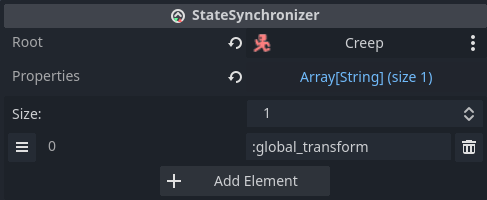StateSynchronizer
Synchronizes state from the node's authority to other peers.
Similar to Godot's MultiplayerSynchronizer, but is tied to the network tick loop. Works well with TickInterpolator.
One way to use this node is to synchronize logic that runs only on the server, for example NPC's in your games. The NPC's are controlled fully by the server, and their state is synchronized to the clients by the StateSynchronizer nodes.
Configuring state
To use StateSynchronizer, add it as a child to the target node, specify the root node, and configure which properties to synchronize:

Root specifies the root node for resolving properties. Best practice dictates to add StateSynchronizer under its target, so Root will most often be the StateSynchronizer's parent node.
Properties are recorded for each tick on the node's authority ( usually the server ), and broadcast to other peers. These are analogous to RollbackSynchronizer's state properties.
See Property paths on how to specify properties.
Changing configuration
StateSynchronizer has to do some setup work whenever the state or the input properties change.
By default, this work is done upon instantiation. If you need to change
properties during runtime, make sure to call process_settings(), otherwise
StateSynchronizer won't apply the changes.
You can change the node's authority without calling process_settings() again.
Make sure that the authority is changed the same way on all peers, to avoid
discrepancies.
When to use StateSynchronizer and MultiplayerSynchronizer
Part of the design philosophy of netfox is to build on top of Godot's networking tools, instead of replacing them.
Both MultiplayerSynchronizer and StateSynchronizer can be used to synchronize state from authority to the rest of the peers.
MultiplayerSynchronizer uses its own timer, and is independent of netfox's network tick loop. It can also do delta updates, and manage visibility per peer. Since it is not tied to netfox's tick loop, it does not work with TickInterpolator.
StateSynchronizer records all the properties specified and broadcasts them as-is to all peers. This does not include visiblity or delta updates. The broadcast happens on every network tick. This node is explicitly designed to work with TickInterpolator.
You can use StateSynchronizer for properties that you want to be interpolated, like position, rotation, or any other visual properties.
You can use MultiplayerSynchronizer for properties that either don't need interpolation ( e.g. a unit's HP ), or specifically need one of MultiplayerSynchronizer's features.